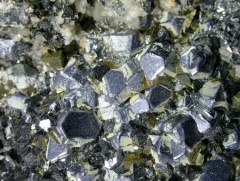Galena
| Infobox on Galena | |
|---|---|
| Example of Galena |  |
| Facts | |
| Origin |
|
| Stowage factor (in m3/t) | - |
| Humidity / moisture | - |
| Ventilation | - |
| Risk factors | - |
Galena
Description
Galena deposits often contain significant amounts of silver as included silver sulfide mineral phases or as limited solid solution within the galena structure. These argentiferous galenas have long been the most important ore of silver in mining. In addition zinc, cadmium, antimony, arsenic and bismuth also occur in variable amounts in lead ores. Selenium substitutes for sulfur in the structure constituting a solid solution series. The lead telluride mineral altaite has the same crystal structure as galena. Within the weathering or oxidation zone galena alters to anglesite (lead sulfate) or cerussite (lead carbonate). Galena exposed to acid mine drainage can be oxidized to anglesite by naturally occurring bacteria and archaea, in a process similar to bioleaching.
Galena deposits are found worldwide in various environments. Colour lead gray, streak lead gray, metallic luster, good cubic cleavage. Soluble in strong nitric acid, also in excess of hot hydrochloric acid.
Galena is the primary ore of lead which is mainly used in making lead-acid batteries; however, significant amounts are also used to make lead sheets and shot. Galena is often mined for its silver content.
Galena is a semiconductor with a small bandgap of about 0.4 eV which found use in early wireless communication systems. For example, it was used as the crystal in crystal radio sets, in which it was used as a point-contact diode to detect the radio signals. The galena crystal was used with a safety pin or similar sharp wire, which was known as a "cat's whisker". Making such wireless sets was a popular home hobby in Britain and other European countries during the 1930s. Derbyshire was one of the main areas where galena was mined. In modern wireless communication systems, galena detectors have been replaced by more reliable semiconductor devices, though silicon point-contact microwave detectors still exist in the market.
Shipment / Storage / Risk factors
Natural lead sulphide used for lead manufacture. May be shipped in bags, drums or in bulk.Is soft, powders readily, and is very dense and heavy. When very soft can oxidize, with toxic sulphur dioxide being released. When such oxidation takes place, the amount of lead is unaffected, but it has to be refined in a different manner. Water flowing over galena does not affect it.
- Melting Point: 1114° C
- Boiling Point: 1281° C
Note Consult the applicable MSDS sheet for safety precautions.











